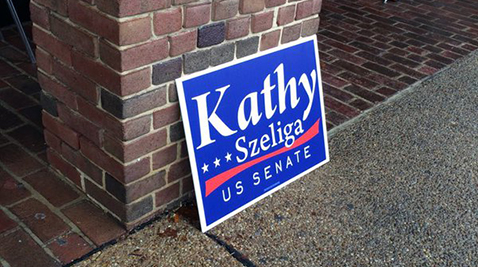WASHINGTON — With less than six months until the Maryland primary, the race for U.S. Senate is heating up in both political parties.
Delegate Kathy Szeliga, R-Baltimore County, who is the House minority whip, announced her candidacy Tuesday, becoming the first Republican lawmaker and the most prominent GOP candidate to enter the race.

Szeliga is attempting to become the first Maryland Republican senator since 1986 – before the retiring Sen. Barbara Mikulski was elected to her first of five terms. Given that registered Democratic voters outnumber Republicans 2-1 in Maryland, the Democratic primary is viewed with the same level of importance as the general election.
The first independent Democratic primary poll, released Oct. 16, showed that Rep. Donna Edwards, of Fort Washington, has a 10-percentage-point lead over Rep. Chris Van Hollen, of Kensington.
However, Marylanders are still waiting on a decision from Rep. Elijah Cummings, D-Baltimore, as to whether he will throw his hat in the ring. The poll found that should Cummings enter race, he would become the immediate favorite and lead both Edwards and Van Hollen by 13 points.
Meanwhile, Van Hollen’s campaign is far from discouraged.
“This poll reflects what everyone has always known,” Van Hollen campaign manager Sheila O’Connell said in a statement. “The campaign depends on the battle for the undecided voters in the Baltimore area. The Post poll was conducted before our campaign aired its first television ad in Baltimore.”
Van Hollen holds a massive 11-1 advantage in cash on hand, and he has done so by dominating the local donations. Seventy eight percent of Van Hollen’s donors are from Maryland, and the campaign has received donations from 22 of the 23 counties in Maryland.
Van Hollen’s $4.1 million cash on hand allowed him to hit the airwaves first, with three successive campaign ads in the past month. The ads are focused on the Baltimore market.
Van Hollen’s advertisements highlight his history of fighting special interests, and his work on gun control and social security.
Edwards acknowledges the financial disadvantage, but touts the idea of smaller donations from grassroots donors. According to the Edwards campaign, more than half of third quarter donations were $10 or less, and a whopping 94 percent of third quarter donations were under $100.
“In spite of our opponent’s fundraising advantage, Marylanders are responding to Donna’s progressive vision for Maryland families while we work every day to solidify our lead in the polls and build an organization that turns our supporters out to vote,” said Ben Gerdes, communications director for the Edwards campaign.
The Edwards campaign boasts about 2,600 volunteers, and its field operation holds regular phone banks in Baltimore City, Prince George’s County and Montgomery County, having already made more than 13,000 calls.
While the Van Hollen campaign does not have nearly as many volunteers – about 1,200 so far – it has made more than 71,000 phone calls to Maryland residents in October, while holding phone banks in eight counties and the Eastern Shore.
Van Hollen has also traveled all over the state of Maryland recently, attending events ranging from crab feasts and picnics to pro-choice galas and education conventions.
These gatherings have taken place in many different counties, including: Anne Arundel County, Baltimore City, Baltimore County, Howard County, Montgomery County, Ocean City and Prince George’s County, among others.
“Everywhere Chris goes, he is meeting with voters who are eager for action on a range of issues,” O’Connell said. “Those Marylanders are the momentum behind this campaign, and Chris is committed to working together with them to move Maryland, and our country, forward.”
Edwards seems more focused on the votes of specific audiences.
In the past few weeks, Edwards has visited Towson University, the University of Maryland, Baltimore County, and Johns Hopkins University, and she has confirmed appearances at both Morgan State and Coppin State Universities on Veterans Day, as well as a scheduled stop at the University of Maryland in College Park on Monday, Nov. 16.
Edwards may have put her college tour to good use, as she now has more than triple the Twitter followers of Van Hollen. However, Van Hollen has more total followers on social media, including more than 10,000 followers on Facebook.
In addition to the younger vote, Edwards has also targeted the vote of senior citizens.
Edwards is wrapping up a multi-day tour of senior centers and retirement communities across the state.
On the GOP side, Szeliga says her candidacy is based on a growing dissatisfaction with the current government.
“We have a paralyzed government incapable of solving even our most basic needs. I for one can no longer standby waiting for those we’ve sent to Washington to solve our problems, because they haven’t,” Szeliga said in a statement.
Given that Maryland has only one other Republican member of Congress, Szeliga’s hopes may be buoyed by the recent election of Republican Gov. Larry Hogan.
“It’s going to take a lot of new people who aren’t professional politicians to step up – average citizens with college degrees and others without. Goodness knows, they can’t be any worse than the gang running things now,” Szeliga added.
Other previously announced Republican Senate candidates include Richard Douglass, a former Pentagon official; Chrys Kefalas, a vice president of communications at the National Association of Manufacturers; Andy Seda, a Navy veteran and substitute teacher; and Daniel Schroeder.
Maryland’s Democratic and Republican primaries are scheduled for April 26, 2016.


You must be logged in to post a comment.